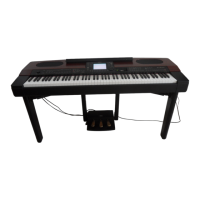PF-1000
90
Recording Your Performances and Creating Songs
— Song Creator
With these powerful yet easy-to-use song creating features, you can record your own keyboard performances and store
them for future recall. Several different recording methods are available: Quick Recording (page 91), which lets you
record easily and quickly; Multi Recording (page 92), which lets you record several different parts; and Step Recording
(page 94), which lets you enter notes one by one. Songs can include not only the voice settings for the keyboard
performance (Main, Layer, Left), but also the effects and auto accompaniment parts. The recorded song can be stored to
internal memory or floppy disk (page 38, 44).
About Song Recording
■ Quick Recording (page 91)
This is the easiest recording method, and lets you quickly record the piano
song you are practicing. You can select from three parts: right hand, left hand
and auto accompaniment. For example, you can record only your right hand
performance, or you can simultaneously record both your right hand and the
auto accompaniment.
■ Multi Recording (page 92)
This lets you record a song with several different instrument sounds, and create
the sound of a full band or orchestra. Record the performance of each
instrument individually and create fully orchestrated compositions. You can
also record over an existing part on an internal song or a song on disk with
your own performance.
■ Step Recording (page 94)
This method is like writing music notation on paper. It lets you enter each note
individually, by specifying the pitch and length. This is ideal for making precise
recordings, or for recording parts that are difficult to play.
■ Song Editing (page 100)
The PF-1000 also lets you edit the songs you’ve recorded by the Quick
Recording, Multi Recording and Step Recording methods.
MASTER VOLUME
MIN MAX
METRONOME
STYLE CONTROL
START/STOP
FADE IN/OUT POP & ROCK
BREAK INTRO
ENDING/rit.
SYNC.STOP SYN C.START
TOPREC
NEW SONG
SYNC.START
EXTRA TRACKS TRACK2
STYLE L
TRACK1
R
START/STOP
START/STOP
REW
FF
REPEAT
DEMO
HELP
FUNCTION
E
D
C
B
A
J
I
H
G
F
SOUND
CREATOR
DIGITAL
RECORDING
DIRECT
ACCESS
BALANCE
CHANNEL
ON/OFF
PART
PART
MIXING
CONSOLE
LCD
CONTRAST
A
ACMP
AUTO FILL IN
OTS LINK
B
MAIN
C
TAP TEMPO
EXIT
DATA ENTRY
ENTER
ON/OFF
LAYER
BACK
LEFT
NEXT
MUSIC
FINDER
RESET RESET
POP BALLADS
DANCE
SWING & JAZZ
R & B COUNTRY
LATIN WALTZ BALLROOM PIANIST
USER 4321
4321FREEZEUSERXGSYNTH.
CHOIR & PAD
BRASS WOODWIND STRINGS
LEFT HOLDMONOECHO
HARMONY/
REVERB
PIANO & ORGAN &
DSP VARIATION
BASSGUITAR
PERCUSSION
HARPSI. E.PIANO
ACCORDION
8 MEMORY765
MARCH &
WORLD
TEMPO
TRANSPOSE
STYLE
SONG
MENU
DIGITAL
STUDIO
2 31 5 6 7 84
VOICE
PART
PIANO
VOICE REGISTRATION MEMORY
VOICE EFFECT ONE TOUCH SETTING
D
TOPREC
NEW SONG
SYNC.START
EXTRA TRACKS TRACK2
STYLE L
TRACK1
R
START/STOP
REW
FF
REPEAT
DIGITAL
RECORDING
SONG
• The internal memory capacity of
the PF-1000 is about 580KB. Mem-
ory capacity for 2DD and 2HD
floppy disks is about 720KB and
1.44MB, respectively. When you
store data to these locations, all file
types of the PF-1000 (Voice, Style,
Song, Registration, etc.) are stored
together.
• The microphone input signal can-
not be recorded.
• Songs recorded on thePF-1000
are automatically recorded as SMF
(Standard MIDI File format 0) data.
For details on SMF see page 148.
• Playback of the recorded song data
can be transmitted from MIDI OUT,
letting you play the sounds of a
connected external tone generator
(page 135).
• The volume level of each channel
of the song can be adjusted from
the Mixing Console and the set-
tings can be saved. Moreover, even
after you’ve set a voice for your
keyboard play during recording,
you can record voice selections, so
that the voice changes automati-
cally during playback (page 102).

